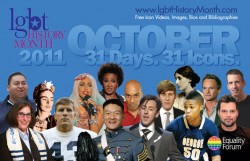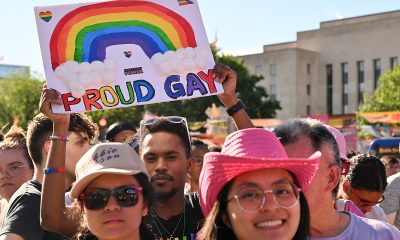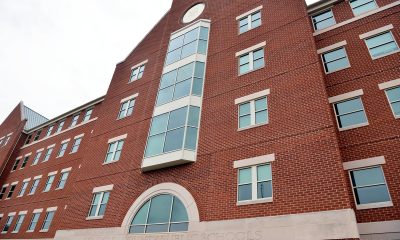Opinions
Teaching LGBT history
When it comes to counting the contributions of LGBT people to society, one month is hardly enough

October is once again LGBT history month, and once again, Equality Forum has chosen 31 brand new LGBT icons to highlight throughout the month.
Every year for the past six years, Equality Forum has chosen a new icon to focus on every day throughout the month of October. Their archives now contain the stories of over 186 LGBT icons from throughout history. Everyone from Alexander the Great to one of this year’s new entries, Lady Gaga.
That’s 186 stories to tell. 186 people who have changed the world in some way.
LGBT people have been making the world better, and contributing to their society in crucial ways for as long as civilization has been in existence.
Despite this, however, LGBT kids throughout the country are constantly told that they aren’t good enough, that they’re worthless, that they are abominations and aberrations. Due to terrible bullying and harassment — sometimes completely facilitated by the school culture and by the adults that should be protecting the kids — hundreds of transgender, lesbian, bisexual and gay kids take attempt to take their lives every year. Many complete those attempts.
Just as we know LGBT people have contributed monumentally to society, we also know that many LGBT kids won’t survive childhood to make it to adulthood where they will truly flourish.
In California, the state legislature made this connection and have made an attempt to try and stem this tide. Recognizing that many bullied LGBT kids may not know about the wonderful contributions that LGBT people make to our world, the California legislature passed a law mandating the inclusion of information about LGBT people in the teaching of history. These are more often than not LGBT people that have been in our history books for generations. Now they’re bringing these figures out of the closet, to help give LGBT kids a sense of pride about being different, to counter the feeling of isolation and poor self-esteem they often receive in the four walls of a classroom.
However, either despite recognizing what this sort of law could do to curb suicide rates with bullied gay kids, or sadly perhaps even because of recognizing, the far right in California is gaining traction in an effort to add to next year’s ballot a measure to repeal the law. They’re nearing their signature goal, and if this repeal makes it to the ballot, it will be a hard battle to keep it, as the enemies of this law will surely choose messaging that scares parents into believing the law will “teach homosexuality.”
One can no more teach homosexuality than one can teach heterosexuality. This is about fairness and accuracy in our classrooms. Accuracy is what we should be striving for in the first place. This law only encodes it.
In defiance of these enemies of LGBT openness, we’re joining with the Equality Forum in helping promote LGBT history this October. We’ve also got several other partners providing us with content throughout the month. Keep checking back to see what we’ll be bringing you.
Below is the press release from Equality Forum about the LGBT history icons. Tomorrow we’ll bring you the first installment from this year’s National Gay History Project in conjunction with our friends at Philadelphia Gay News. Please spread the world, and let’s celebrate our community’s history, strength and contributions.
LGBT History Month Starts Saturday
Featured Icons for October 1st to October 7th
LGBT History Month 2011 (www.lgbtHistoryMonth.com) starts Saturday, October 1st.
LGBT History Month provides role models, teaches history, builds community, and celebrates our community’s important national and international contributions.
“LGBT History Month 2011 includes outspoken Lady Gaga, “Milk” screenwriter and Oscar winner Dustin Lance Black, “Don’t Ask, Don’t Tell” repeal activist Dan Choi, national hero Daniel Hernandez Jr., internationally acclaimed Mexican artist Frida Kahlo, first elected transgender judge Victor Kolakowski, Ugandan leader David Kato, singer Ricky Martin and satirist Wanda Sykes,” stated Malcolm Lazin, Executive Director, Equality Forum and founder of LGBT History Month. “We can take real pride in the 31 Icons for 2011 and the 155 Icons from 2006 to 2010, all of whom are archived on the site.”
Each day in October, an Icon is featured with a free video, biography, bibliography, downloadable images and other educational resources. A free and easily embedded video player provides the Icon’s video, which is automatically updated daily starting Saturday.
Through a grant from the MAC AIDS Fund, LGBT History Month 2011 includes an internal search engine for all 186 Icons from 2006 – 2011. By clicking on “Icon Search” and choosing from over 200 tags, users will find links to all Icons in that category and their resources.
LGBT History Month Icons – Week 1
Kye Allums – Saturday, October 1st
Allums is the first openly transgender athlete to play NCAA Division 1 basketball.
John Ashbery – Sunday, October 2nd
One of the most successful poets, Ashbery has won almost every major literary award, including the Pulitzer Prize.
Alison Bechdel – Monday, October 3rd
A celebrated cartoonist, Bechdel is the author of the long running comic strip Dykes To Watch Out For.
John Berry – Tuesday, October 4th
Director of the U.S. Office of Personnel Management, Berry is the highest-ranking openly gay federal employee in U.S. history.
Dustin Lance Black – Wednesday, October 5th
A screenwriter, director and producer, Black received an Academy Award for Best Original Screenplay for “Milk.”.
Keith Boykin – Thursday, October 6th
A political commentator and a New York Times best-selling author, Boykin is a veteran of two presidential campaigns.
Rita Mae Brown – Friday, October 7th
A novelist and a screenwriter, Brown is best known for her semi-autobiographical lesbian themed-book “Rubyfruit Jungle.”
October LGBT History Month Icons
1st Kye Allums – Athlete
2nd John Ashbery – Poet
3rd Alison Bechdel – Cartoonist
4th John Berry – Government Official
5th Dustin Lance Black – Screenwriter
6th Keith Boykin – Commentator
7th Rita Mae Brown – Author
8th Dan Choi – Activist
9th Aaron Copland – Composer
10th Alan Cumming – Actor
11th Denise Eger – Rabbi
12th Lady Gaga – Singer
13th Michael Guest – Diplomat
14th Neil Patrick Harris – Actor
15th Daniel Hernandez Jr. – Hero
16th Langston Hughes – Author
17th Frida Kahlo – Artist
18th David Kato – Ugandan Activist
19th Michael Kirby – Supreme Court Justice
20th Victoria Kolakowski – Judge
21st Dave Kopay – Athlete
22nd Ricky Martin – Singer
23rd Amélie Mauresmo – Athlete
24th Constance McMillen – Youth Activist
25th Ryan Murphy – Writer/Director
26th Dan Savage – Journalist/Author
27th Amanda Simpson – Government Official
28th Wanda Sykes – Comedian/Actor
29th Lilli Vincenz – Gay Pioneer
30th Virginia Woolf – Author
31st Pedro Zamora – AIDS Activist, MTV Personality
Equality Forum (www.equalityforum.com), a national and international LGBT civil rights organization with an educational focus, coordinates LGBT History Month worldwide, produces documentary films, undertakes high-impact initiatives and presents annually the largest national and international LGBT civil rights summit.
Opinions
Lighting candles in a time of exhaustion
Gunmen killed 15 people at Sydney Hanukkah celebration

In the wake of the shooting at Bondi Beach that targeted Jews, many of us are sitting with a familiar feeling: exhaustion. Not shock or surprise, but the deep weariness that comes from knowing this violence continues. It is yet another reminder that antisemitism remains persistent.
Bondi Beach is far from Washington, D.C., but antisemitism does not respect geography. When Jews are attacked anywhere, Jews everywhere feel it. We check on family and friends, absorb the headlines, and brace ourselves for the quiet, numbing normalization that has followed acts of mass violence.
Many of us live at an intersection where threats can come from multiple directions. As a community, we have embraced the concept of intersectional identity, and yet in queer spaces, many LGBTQ+ Jews are being implicitly or explicitly asked to play down our Jewishness. Jews hesitate before wearing a Magen David or a kippah. Some of us have learned to compartmentalize our identities, deciding which part of ourselves feels safest to lead with. Are we welcome as queer people only if we mute our Jewishness? Are those around us able to acknowledge that our fear is not abstract, but rooted in a lived reality, one in which our friends and family are directly affected by the rise in antisemitic violence, globally and here at home?
As a result of these experiences, many LGBTQ+ Jews feel a growing fatigue. We are told, implicitly or explicitly, that our fear is inconvenient; that Jewish trauma must be contextualized, minimized, or deferred in favor of other injustices. Certainly, the world is full of horror. And yet, we long for a world in which all lives are cherished and safe, where solidarity is not conditional on political purity or on which parts of ourselves are deemed acceptable to love.
We are now in the season of Chanuka. The story of this holiday is not one of darkness vanishing overnight. It is the story of a fragile light that should not have lasted. Chanukah teaches us that hope does not require certainty; it requires persistence and the courage to kindle a flame even when the darkness feels overwhelming.
For LGBTQ+ Jews, this lesson resonates deeply. We have survived by refusing to disappear across multiple dimensions of our identities. We have built communities, created rituals, and embraced chosen families that affirm the fullness of who we are.
To our LGBTQ+ siblings who are not Jewish: this is a moment to listen, to stand with us, and to make space for our grief. Solidarity means showing up not only when it is easy or popular, but especially when it is uncomfortable.
To our fellow Jews: your exhaustion is valid. Your fear is understandable, and so is your hope. Every candle lit this Chanukais an act of resilience. Every refusal to hide, every moment of joy, is a declaration that hatred will not have the final word.
Light does not deny darkness. It confronts it.
As we light our candles this Chanuka season, may we protect one another and bring light to one another, even as the world too often responds to difference with violence and hate.
Joshua Maxey is the executive director of Bet Mishpachah, D.C.’s LGBTQ synagogue.
Opinions
Holidays not always bright for transgender people
‘Home’ often doesn’t feel like home for trans folks

Christmas is family time, isn’t it? It seems like every TV ad, every rom-com with a Christmas tree and fairy lights, every festive novel in your local bookshop is trying to persuade you of this. To push it on you — and what’s wrong with it, you may ask? Well, just think about the thousands of people who cannot spend this holiday season with their loved ones. Think about the transgender community specifically.
Even without the increasingly hostile political climate against trans people in modern-day America, many of them are not welcome in their own families. It is not something that started with MAGA, although MAGA certainly made it worse. “Home Alone” is not a comedy when your family does not accept you, and you are stuck all alone on Christmas. I’ve never been alone at holidays, but I know — as a trans person who has always loved family stories but estranged from their family — how the season can be tough.
Let’s make it clear: I like the holiday season, and I would never ask you to cancel it. I just want you to support your trans friends, and the trans community in general.
According to recent data from the Williams Institute at UCLA, more than 2.8 million people in the U.S. now identify as trans, including roughly 724,000 youth aged 13–17. And not all of them are out or accepted at home. That means many thousands are navigating teenage years — the years when so many family traditions, holidays, and emotional expectations are formed — while being invisible to their own families, or abused by them.
But for a large proportion of trans people, “home” doesn’t feel like home.
In the landmark 2015 U.S. Transgender Survey, many of respondents who were out to their immediate family reported some form of rejection: relationships ending, being kicked out, being denied the ability to express their gender, or being sent away.
Among those who did experience family rejection, 45 percent had experienced homelessness.
Other research shows how deeply rejection affects health: trans youth without family support face far higher rates of psychological distress, suicidality, and substance misuse.
So when you hear “Christmas is family time,” for many trans adults that message comes with flashbacks and pain. For trans kids it may be worse.
Also, intersectionality made everything even hard. Take trans people of color. A report on Black trans Americans found:
- 42 percent had experienced homelessness
- 38 percent lived in poverty
- Rates of sexual violence, mistrust of authorities, and fear of asking for help were also significantly higher
And if a trans person is also disabled, autistic, or living with chronic health conditions, the barriers become even bigger. Just imagine what it is like when your parents try to change you for being autistic all your childhood, and then kick you up for being trans. Ableism often goes hand in hand with transphobia; support systems become less accessible; and acceptance becomes harder to find. Holidays meant not just that you sometimes couldn’t share fun because of lack of inclusion now, but also because of mental health issues triggered by the past.
So yes — when you talk about Christmas stories of family, warmth, fairy lights and acceptance, it’s important to remember that for many trans people, Christmas is not something nice and cozy. Many trans people are suffering from PTSD, and for people with PTSD holidays are often a trigger.
So what can you do, as a trans ally or another trans person who wants to help their trans siblings? What does a “trans-friendly Christmas” look like for those estranged from their families?
Supporting a trans person at Christmas doesn’t have to be perfect. It doesn’t demand huge gestures, it doesn’t mean that you should stop celebrating or play Grinch. Just remember that not everyone is celebrating. And even people like me, who are celebrating, sometimes feel too triggered by all the perfect family pictures.
But there is some way to help your trans friends.
Give them space. Not everyone wants to talk about Christmas. Not everyone wants to explain their estrangement. They may withdraw, or avoid festive events entirely. Respect that. As an expert working with mental health services, I can say that sometimes the best gift is the room to breathe.
Say: “I know this time of year can be difficult. I’m here if you want to speak, and I’m here if you don’t.” Or share your own bad experience, especially if you are speaking with autistic person.
Or just ready to support them in a way they need.
Acknowledge the pain, without feeling guilty if it’s not your fault, and provide some support.
This might mean:
- Inviting them to your home for a meal
- Checking in with a simple, trans-friendly message (“thinking of you today — hope you’re doing whatever feels right for you”) — especially if they like this kind of messages
- Suggesting a walk, a film night, or anything that doesn’t revolve around “family”
- Bringing them into chosen family traditions if they’re open to it
- Support trans community online
- Just share photos of your pets
Be prepared for triggers. Really. I often have a relapse in my mental health on holidays despite liking them. Or, because I have Dissociative Identity Disorder, I struggle with my child’s personality. Your friends who have PTSD or DID can have similar problems. Respect them even if they behave “childishly” — even when a person is mentally falling into their child state, remember that they still have agency. Listen to their stories. Help them create their own holiday traditions if they need to, or ask for professional help. Be patient. Depression, anxiety, or OCD can also be triggered during holidays even if a person with those conditions is in remission.
And, most important of all: listen.
Some trans people want community on Christmas. Some want silence. Some want to escape. Some want a tiny piece of normality. Some want their own queer or geeky Christmas. Some prefer to celebrate the new year. There is no universal script. Let them decide. And remember: support is the most important thing.
Not the holiday decorations. Not the perfectly curated “inclusive holiday.” Not expensive parties.
Because for many trans people who have lost their family, especially at Christmas, it is important to know that someone sees them, someone calls them by their chosen name, someone cares, someone wants them here even if their parents don’t.
And sometimes, that’s enough to make the season not just survivable, but enjoyable. This, by the way, is true for all holidays, whether it’s Hanukkah or New Year’s Eve.
Opinions
Reflecting on six years on the CAMP Rehoboth board
Purpose, people, and the power of community

Some people let life happen; I prefer to plan it—meticulously, intentionally, and yes, sometimes overboard. After losing many loved ones and navigating my own setbacks, I learned not to let life drift by; instead, I live it with intention—curating the people, commitments, and actions that bring joy and meaning, even if others mistake that intentionality for control.
True to form, I close each year with an annual life audit reflecting to see if my personal goals were achieved and, if not, why did I fall short. This habit reflects a simple philosophy: fulfillment doesn’t happen by accident. It comes from daring to imagine the life you want and living deliberately at work, in service to others, and in the everyday moments that make life meaningful.
This year’s assessment is a bit more complicated because on Dec. 31 I will conclude six years on the board of CAMP Rehoboth Community Center — two full three-year terms, including three years as board president. When putting pen to paper, I quickly realized the lessons from the last 12 months were six years in the making.
For those who may not know, CAMP Rehoboth (CAMP is an acronym for Create A More Positive) is widely recognized as the leading provider of life-affirming programs and services in support of LGBTQ people in Rehoboth Beach, Del., and the greater Sussex County area. Since its founding 34 years ago, CAMP’s work has enabled LGBTQ people to thrive. In fact, it is the reason my husband Greg and I (along with thousands of other LGBTQ people) decided to make this part of Delaware our home.
If the past few years have taught me anything, it is that leadership is not a position—it is a practice. It is a daily decision to show up with clarity, steadiness, and a willingness to hold space for others as we navigate change together.
Purpose is the compass. Purpose gives direction when circumstances shift, resources tighten, and competing demands threaten to pull us off course. At CAMP Rehoboth, our purpose has always been to ensure LGBTQ people have access to life-affirming programs, culturally competent services, and a place where they feel seen, valued, and supported. Purpose guided our leadership transition and executive director search, reminding us that the leader our community deserves must bring experience, emotional intelligence, and a deep understanding of what belonging means.
Values are the guardrails. They keep us aligned when opportunities, distractions, or pressures arise. Our values show up in our strategic planning, financial stewardship, and insistence that inclusion is a practice, not a slogan. They ensure that when challenges—political hostility, funding uncertainty, changing community needs—emerge, we respond with integrity instead of reaction.
People are the engine. Organizations don’t create impact — people do. Staff, volunteers, board members, donors, and community members together make the mission real. Investing in their capacity, wellness, and professional development ensures they can do their best work. When we take care of our people, they take care of the community.
I am a gay man who knows how obstacles can feel insurmountable and hope can falter having lived through the AIDS epidemic and fought for civil rights like the legalization of same-sex marriage. In those moments, I chose to focus on what I could control rather than what I could not. Getting involved gave me purpose and proved that fulfillment comes from taking action to make a difference—for yourself and for the broader community.
Gratitude is the culture.
As I close this chapter, what I feel most is gratitude. Gratitude honors those who built the foundation, celebrates those who carry the work forward, and reminds us that progress is a collective effort. Thank you to our staff, especially Executive Director Kim Leisey, who serve with skill and heart; to our volunteers like former board member Chris Beagle and current board president Leslie Ledogar, who give more than anyone will ever know; to our donors, who invest in possibility; and to the community that trusts us to be there in moments of celebration, struggle, and change. Finally, none of this would have been possible without the steadfast love of my husband and the unwavering support of close friends who lifted me in the moments I needed it most.
Reflection, planning, and intentionality do not guarantee perfection — but they make fulfillment possible. Life is too short to leave it to chance. By daring to dream, acting deliberately, and giving generously, we can create lives that are both meaningful and impactful — not just for ourselves, but for the communities we touch.
Wes Combs is an outgoing board member of CAMP Rehoboth.
-

 The White House5 days ago
The White House5 days agoAs house Democrats release Epstein photos, Garcia continues to demand DOJ transparency
-

 District of Columbia5 days ago
District of Columbia5 days agoCapital Pride announces change in date for 2026 D.C. Pride parade and festival
-

 Virginia5 days ago
Virginia5 days agoDOJ seeks to join lawsuit against Loudoun County over trans student in locker room
-

 Photos4 days ago
Photos4 days agoPHOTOS: The Holiday Show

















